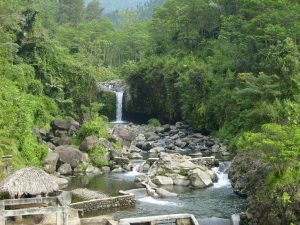When it comes to romance, some seem to prefer fantasy to reality. The world boats famous eternal love monuments: the Taj Mahal in Agra, India, a love symbol of the Fifth Mughal Emperor Shah Jahan for his third wife Mumtaz Mahal; Altenau Palace (now Mirabell Palace) in Austria, built by the prince-archbishop Wolf Dietrich von Raitenau for his mistress, and the palace’s namesake, Salome Alt; Thailand’s Prasat Hin Phimai, of the tragic love story between Prince Pajitt and his wife Oraprima. Indonesia too has its monuments of love.
Though not confined to just buildings and structures, there are also forests, mountains, valleys and temples across Indonesia bound by the same force: love. Though sprinkled with myth and magic — what good story isn’t? — these destinations have found their place in Indonesia’s storybooks as eternal legends of love. So legendary are these destinations that pilgrimages are made to them, and fantastical retellings of their stories made in film and fairy tale.
 BATURADEN
BATURADEN
Purwokerto, Central Java
On the south side of Mount Slamet is a 16-hectare forest area known as Baturaden, found in the Banyumas Regency. The area’s background story rivals that of any soap opera. A duke from the Kutaliman Regency, west of Baturaden, was said to have the most beautiful daughter in the land. Inevitably, a young man in close proximity to her fell smitten to the maiden — but, he was the duke’s servant, named Suta. With caste systems strict in such times, the relationship was impossible. Suta and the duke’s daughter were in love, the naive servant asking for her hand in marriage. This act of insolence saw him thrown into the dungeons… but love prevailed and the two fled on horseback, disguised as country folk, settling down in the forested highlands. The area in which they resided became known as Baturaden, taking its name from the combination of the words batur (servant) and raden (noble).

TANGKUBAN PERAHU
Bandung, West Java
This iconic volcano that straddles the highland city of Bandung has its own tragic love story. There was once a young man named Sangkuriang, who fell in love with a beautiful, though older, woman named Dayang Sumbi. Sangkuriang wanted to marry her, and proposed. However, Dayang Sumbi spotted a scar atop the young man’s head — the exact same scar as her son, who was separated from her at a young age. Upon this realisation, that they were in fact mother and son, she set him on an impossible task to ‘prove’ his worthiness, in hopes it would surrender their matrimony: he must build a ship upon the lake before sunrise.
The motivated Sangkuriang summoned djinns with black magic to help him with the task. Seeing his progress, and potential success, Dayang Sumbi prayed to the god Sang Hyang Tunggal to help her. Her prayers saw a miracale, the roosters crowed early that morning, making the djinns think morning had come and Sangkuriang had failed his task. His failure put the lovestruck son into a fury, kicking his almost-finished ship causing it to topple over, making the mountain we now know as ‘Tangkuban Perahu’, or ‘overturned boat’, which is what it resembles when viewed from Bandung.

SITI NURBAYA BRIDGE
Padang, West Sumatra
The novel, Sitti Nurbaya: Kasih Tak Sampai (unrealised love) by Marah Rusli vividly describes the unrealised love drama between Sitti Nurbaya and Samsul Bahri. These two characters loved each other but could not be together because Sitti Nurbaya is forced to marry an old man, Datuk Maringgih, to pay off her father’s debt. It is a love story of Shakespearean-level tragedy. Spoiler alert: Sitti dies, and her body is buried upon Gunung Padang. The 156 metre Sitti Nurbaya Bridge, named after the story and legend, is the main connection between the city of Padang and ‘Bukit Sitti Nurbaya’, also known as Gunung Padang.

LAKE BATUR
Kintamani, Bali
Even though they have been married for a long time, a culturally different couple, Sri Jaya Pangus, King of the Panarajon Kingdom in Kintamani, and Kang Ching Wie, the daughter of a rich Chinese merchant, have not been blessed with children. To get guidance, the king then decided to meditate in the temple around Lake Batur. There, the king met and had an affair with Dewi Danu, the goddess of the lake. They married and had a son, Mayadenawa. Kang Ching Wie went to the Lake Batur to find her husband and found the painful fact. Dewi Danu, who felt that her husband had lied to her, was angry and cursed the king and empress to turn to stone. Regretting her actions, Dewi Danu then created a barong landung statue with a figure resembling a king and queen and asked the people to care for and respect it. The figure of barong landung will appear during the sacred gambuh (one of the oldest Balinese dances) ritual, often seen during the Galungan and Kuningan festivals.

PRAMBANAN TEMPLE
Sleman, Yogyakarta
In the midst of the conflict between the two Hindu kingdoms, the prince of Bandung Bondowoso fell in love with the daughter of the enemy kingdom, Rara Jongrang. Successfully conquering the enemy kingdom, Bandung Bondowoso also intended to marry Rara Jongrang. The princess who knows that Bandung Bondowoso is her father’s killer sets two conditions to marry her. First, she wanted the prince to make a Jalatunda well and the second is to make 1,000 temples in a day. To thwart the prince’s efforts, Roro Jongrang ordered the rooster to crow earlier so that Bandung would think that his time was up and he would not succeed in settling her demands. Knowing the princess’ cheating, the prince cursed her to become a statue within the thousandth temple which was almost finished. The statue of the beautiful princess can still be seen at Prambanan Temple to this day.







